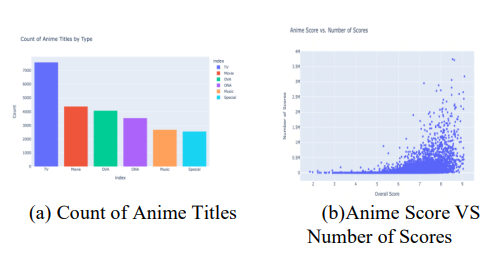Unlocking Personalized Anime Recommendations: Langchain and LLM at the Forefront
DOI:
https://doi.org/10.5281/zenodo.10878197References:
27Keywords:
Recommendation System, Langchain, Large Language Models, Data Analysis, Vector Database, Prompt EngineeringAbstract
This paper introduces an innovative recommendation system that leverages Langchain and Large Language Models (LLMs) to provide tailored anime suggestions. By employing a sophisticated data analysis and model training framework, the system significantly enhances the accuracy and relevance of recommendations. Utilizing a vector database for efficient similarity searches and a novel approach to prompt engineering, the system adeptly interprets user preferences, thereby delivering personalized content recommendations. The integration of Langchain with LLMs showcases a significant advancement in the application of AI-driven techniques in recommendation systems. Our findings indicate that the proposed system not only improves recommendation quality but also offers insights into the effective utilization of language models and retrieval-based QA in the domain of personalized entertainment.
Downloads
Metrics
References
Adomavicius, G., & Tuzhilin, A. (2005). Toward the next generation of recommender systems: A survey of the state-of-the-art and possible extensions. IEEE transactions on knowledge and data engineering, 17(6), 734-749.
Koren, Y., Bell, R., & Volinsky, C. (2009). Matrix factorization techniques for recommender systems. Computer, 42(8), 30-37.
Liu, W., Wang, Z., Liu, X., Zeng, N., Liu, Y., & Alsaadi, F. E. (2017). A survey of deep neural network architectures and their applications. Neurocomputing, 234, 11-26.
Kaiyu, W., Yumei, W., & Lin, Z. (2014, September). A new three-layer QoE modeling method for HTTP video streaming over wireless networks. In 2014 4th IEEE International Conference on Network Infrastructure and Digital Content (pp. 56-60). IEEE.
Goldberg, D., Nichols, D., Oki, B. M., & Terry, D. (1992). Using collaborative filtering to weave an information tapestry. Communications of the ACM, 35(12), 61-70.
He, X., Liao, L., Zhang, H., Nie, L., Hu, X., & Chua, T. S. (2017, April). Neural collaborative filtering. In Proceedings of the 26th international conference on world wide web (pp. 173-182).
Covington, P., Adams, J., & Sargin, E. (2016, September). Deep neural networks for youtube recommendations. In Proceedings of the 10th ACM conference on recommender systems (pp. 191-198).
He, X., Du, X., Wang, X., Tian, F., Tang, J., & Chua, T. S. (2018). Outer product-based neural collaborative filtering. arXiv preprint arXiv:1808.03912.
Mnih, A., & Salakhutdinov, R. R. (2007). Probabilistic matrix factorization. Advances in neural information processing systems, 20.
Wang, H., Wang, N., & Yeung, D. Y. (2015, August). Collaborative deep learning for recommender systems. In Proceedings of the 21th ACM SIGKDD international conference on knowledge discovery and data mining (pp. 1235-1244).
Rendle, S., Freudenthaler, C., Gantner, Z., & Schmidt-Thieme, L. (2012). BPR: Bayesian personalized ranking from implicit feedback. arXiv preprint arXiv:1205.2618.
Bell, R. M., & Koren, Y. (2007). Lessons from the Netflix prize challenge. Acm Sigkdd Explorations Newsletter, 9(2), 75-79.
Linden, G., Smith, B., & York, J. (2003). Amazon. com recommendations: Item-to-item collaborative filtering. IEEE Internet computing, 7(1), 76-80.
Wang, K., Wang, Y., Li, H., Xiong, Y., & Zhang, X. (2014, May). A new approach for detecting spam microblogs based on text and user's social network features. In 2014 4th International Conference on Wireless Communications, Vehicular Technology, Information Theory and Aerospace & Electronic Systems (VITAE) (pp. 1-5). IEEE.
Salakhutdinov, R., & Mnih, A. (2008, July). Bayesian probabilistic matrix factorization using Markov chain Monte Carlo. In Proceedings of the 25th international conference on Machine learning (pp. 880-887).
Wang, J., Yu, L., Zhang, W., Gong, Y., Xu, Y., Wang, B., ... & Zhang, D. (2017, August). Irgan: A minimax game for unifying generative and discriminative information retrieval models. In Proceedings of the 40th International ACM SIGIR conference on Research and Development in Information Retrieval (pp. 515-524).
Zhang, S., Yao, L., Sun, A., & Tay, Y. (2019). Deep learning based recommender system: A survey and new perspectives. ACM computing surveys (CSUR), 52(1), 1-38.
Wang, Y., Sun, M., Wang, K., & Zhang, L. (2016). Quality of experience estimation with layered mapping for hypertext transfer protocol video streaming over wireless networks. International Journal of Communication Systems, 29(14), 2084-2099.
Pan, R., Zhou, Y., Cao, B., Liu, N. N., Lukose, R., Scholz, M., & Yang, Q. (2008, December). One-class collaborative filtering. In 2008 Eighth IEEE international conference on data mining (pp. 502-511). IEEE.
Hu, Y., Koren, Y., & Volinsky, C. (2008, December). Collaborative filtering for implicit feedback datasets. In 2008 Eighth IEEE international conference on data mining (pp. 263-272). Ieee.
Cheng, H. T., Koc, L., Harmsen, J., Shaked, T., Chandra, T., Aradhye, H., ... & Shah, H. (2016, September). Wide & deep learning for recommender systems. In Proceedings of the 1st workshop on deep learning for recommender systems (pp. 7-10).
Cheng, S., Chu, B., Zhong, B., Zhang, Z., Liu, X., Tang, Z., & Li, X. (2021). DRNet: Towards fast, accurate and practical dish recognition. Science China Technological Sciences, 64(12), 2651-2661.
Yan, X., Xiao, M., Wang, W., Li, Y., & Zhang, F. (2024). A Self-Guided Deep Learning Technique for MRI Image Noise Reduction. Journal of Theory and Practice of Engineering Science, 4(01), 109-117.
Zhang, Z., Zhong, B., Zhang, S., Tang, Z., Liu, X., & Zhang, Z. (2021). Distractor-aware fast tracking via dynamic convolutions and mot philosophy. In Proceedings of the IEEE/CVF conference on computer vision and pattern recognition (pp. 1024-1033).
Weimin, W. A. N. G., Yufeng, L. I., Xu, Y. A. N., Mingxuan, X. I. A. O., & Min, G. A. O. (2024). Enhancing Liver Segmentation: A Deep Learning Approach with EAS Feature Extraction and Multi-Scale Fusion. International Journal of Innovative Research in Computer Science & Technology, 12(1), 26-34.
Pan, Zhenyu, et al. "CoRMF: Criticality-Ordered Recurrent Mean Field Ising Solver." arXiv preprint arXiv:2403.03391 (2024).
Hu, Zhirui, et al. "On the design of quantum graph convolutional neural network in the nisq-era and beyond." 2022 IEEE 40th International Conference on Computer Design (ICCD). IEEE, 2022.

Downloads
Published
How to Cite
Issue
Section
License
Copyright (c) 2024 Journal of Industrial Engineering and Applied Science

This work is licensed under a Creative Commons Attribution 4.0 International License.
















